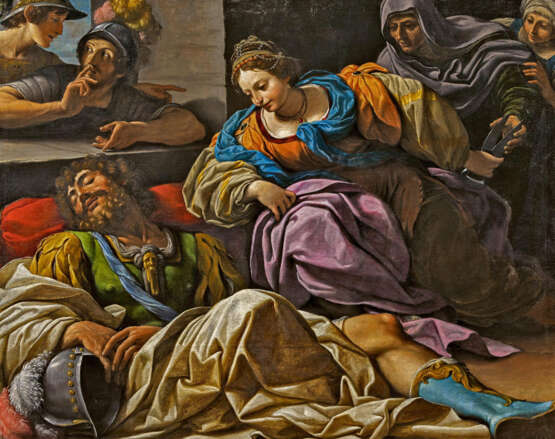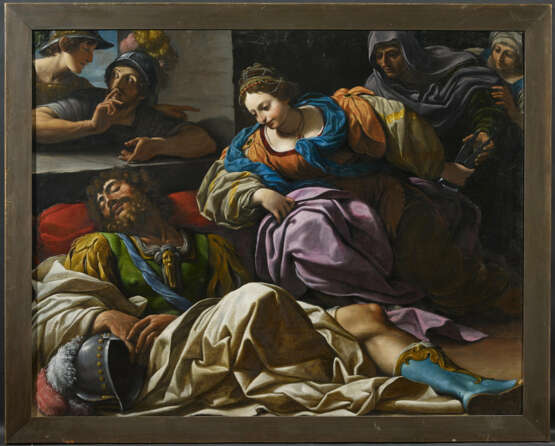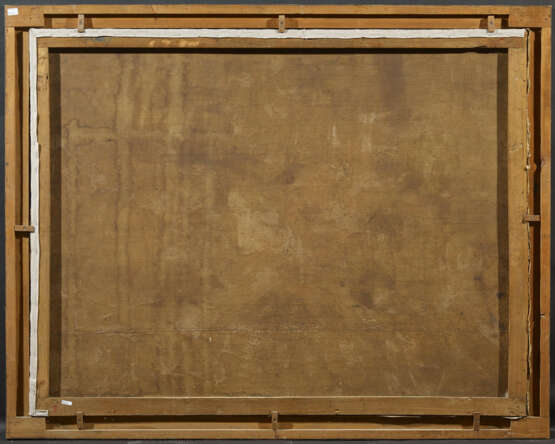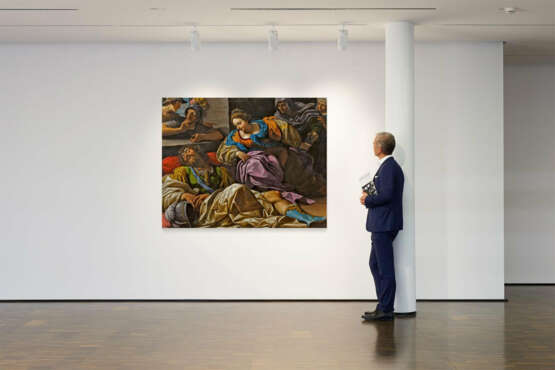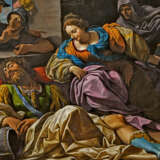ID 548778
Lot 941 | Samson and Delilah
Valeur estimée
€ 40 000 – 80 000
1576 Bologna - 1622 Parma
Title: Samson and Delilah.
Technique: Oil on canvas.
Mounting: Edges relined.
Measurement: 152 x 193cm.
Frame/Pedestal: Framed.
Provenance:
Private ownership, Germany.
The present painting comes from a private collection in Germany, where it has been kept for about a century with the attribution to the Italian school. The correct attribution to the Bolognese painter Lionello Spada was suggested by Davide Dossi in the course of cataloguing the painting and confirmed by Daniele Benati.
The large-format painting depicts an Old Testament narrative from the Book of Judges about Samson, a hero with tremendous strength bestowed upon him directly by God. Delilah, who is in love with the hero, learns that Samson's strength lies in his hair, whereupon - in agreement with the Philistines, who had promised her a great, tempting reward - she makes Samson fall asleep on her knees and cuts off his hair. After losing his strength, Samson is blinded by the Philistines, captured and taken to Gaza, where he is put in chains to turn the millstone in a prison.
The scene depicted in the painting shows the moment when Samson is sleeping on the lap of Delilah, who in turn is handed a pair of scissors by an old woman in the background - without taking her eyes off the sleeping Samson. Two Philistines on the left observe the scene, but the undisputed protagonists are Delilah and Samson, whose bodies take up most of the picture space. This depiction was particularly popular in the first decades of the 17th century: almost every artist tried his hand at this subject, which could be understood as both a moral warning and a gallant scene.
It can be assumed that the present work, whose patron and provenance are as yet unknown before about 1900, was painted in the second decade of the 17th century. After a stay in Malta between 1609 and 1610, where Lionello Spada was commissioned to fresco three rooms of the Grand Master's Palace, and a stay of about five years in Rome, Spada returned to Bologna around 1614. The painting with Delilah and Samson was probably created during his second creative period in Bologna, due to the obvious stylistic affinities with other works. These stand out in particular in the skill and inclination for perspective decoration learned in his early youth (which the artist used again several decades later), the ornamental richness and the neo-Mannerist colours. All these are elements that added up to a renewed classicist manner, enlivened by the art of Domenichino and Annibale Carracci in Rome and Naples. A particularly interesting comparison can be made with the work "The Concert" in the Louvre, which Spada painted around 1615. Here, too, the stylistic features mentioned above can be seen, which inextricably link the two paintings.
We are grateful to Daniele Benati, Bologna, for confirming the attribution of the present painting on the basis of a high-resolution digital photograph.
| Artiste: | Leonello Spada (1576 - 1622) |
|---|---|
| Technique appliquée: | Peinture à l'huile |
| Catégorie maison de vente aux enchères: | Vieux maîtres |
| Artiste: | Leonello Spada (1576 - 1622) |
|---|---|
| Technique appliquée: | Peinture à l'huile |
| Catégorie maison de vente aux enchères: | Vieux maîtres |
| Adresse de l'enchère |
VAN HAM Kunstauktionen GmbH Hitzelerstr. 2 50968 Köln Allemagne | ||||||||||||||
|---|---|---|---|---|---|---|---|---|---|---|---|---|---|---|---|
| Aperçu |
| ||||||||||||||
| Téléphone | +49 221 92586215 | ||||||||||||||
| Fax | +49 221 92 58 62 4 | ||||||||||||||
| Commission | 32% | ||||||||||||||
| Conditions d'utilisation | Conditions d'utilisation | ||||||||||||||
| Heures d'ouverture | Heures d'ouverture
|
